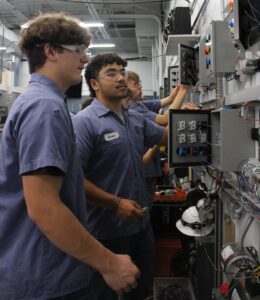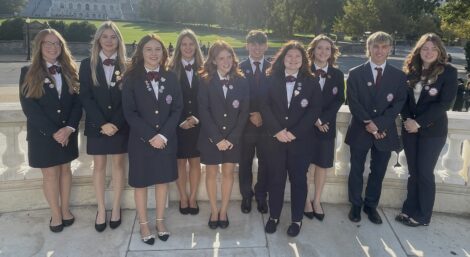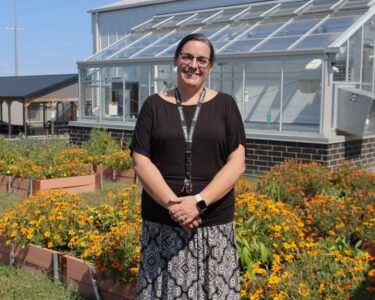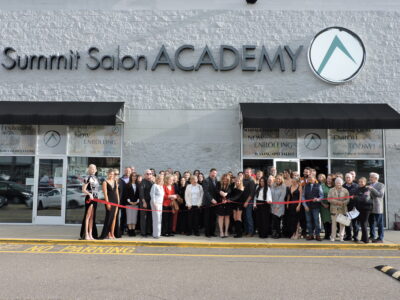SVRTA anticipating big year with upgrades, expansions in store
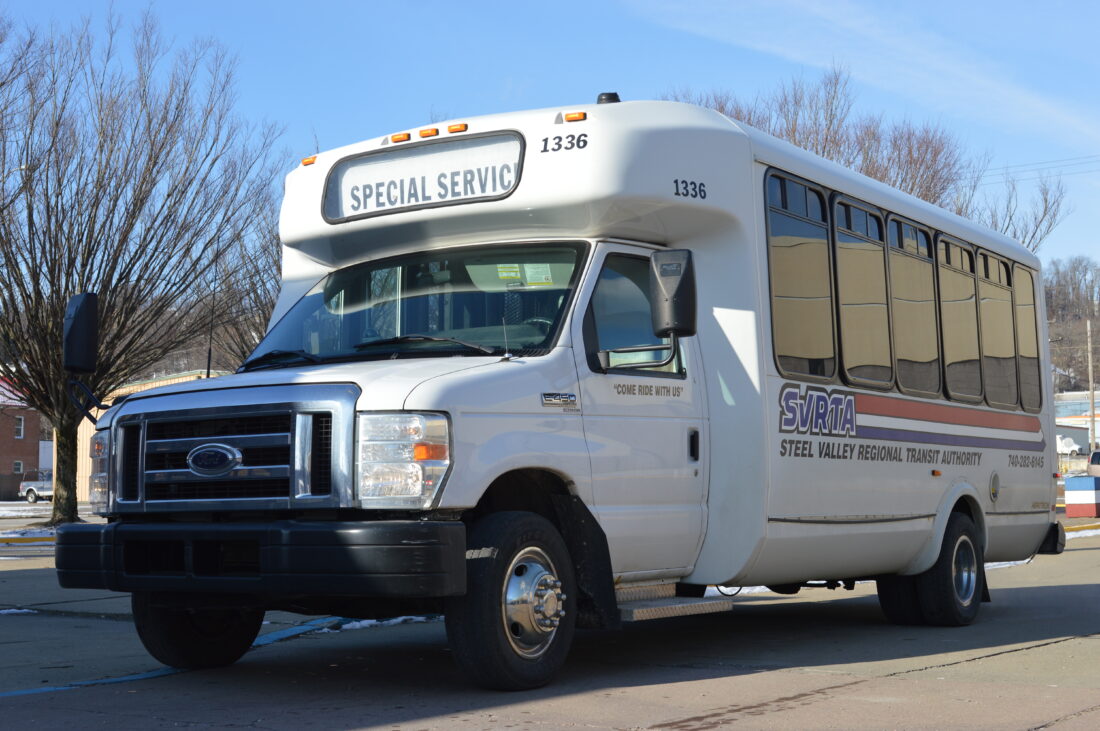
RIDE WITH US — A Steel Valley Regional Transit Authority bus idled outside the authority’s Robert J. Cutri Multi-Modal Center on Adams Street in Steubenville. -- Christopher Dacanay
STEUBENVILLE — In the Nov. 5 general election, a majority of voters in Steubenville, Mingo Junction and Wintersville elected to renew a tax levy supporting the Steel Valley Regional Transit Authority. Last passed in 2014, the 1.5-mill levy this year carried a .5-mill increase — for a total of 2 mills — to account for rising costs and desired service expansions.
The 1.5-mill levy sufficed and received voter support for 30 years before the increase, which took effect at the beginning of 2025. SVRTA transit manager Tim Turner expressed his gratitude Feb. 3 for voters, who he said place their confidence in the SVRTA and its services.
“This will hopefully help us, for the next 30 years, continue to provide even greater service — bigger, better,” Turner said. “What we compare ourselves to is Cleveland, Columbus and Pittsburgh. We’re just trying to do what they do on our scale. So, we want to rival the big cities. We want to give you the best experience you can possibly even begin to have — making it enjoyable, flexible — and get you home safely.”
While the SVRTA campaigned for its levy increase in 2024, its ridership was in the midst of a substantial increase. Now, going into 2025, the transit authority is looking to upgrade its buses, implement new technology, grow its downtown Steubenville footprint and extend its services even farther for the benefit of Jefferson County riders.
Last year, Turner reported, the SVRTA’s ridership increased by 14.6 percent, from 151,366 passenger trips in 2023 to 173,476 in 2024. That’s part of a broader trend of steady increase following the COVID-19 pandemic, Turner said.
One reason for that increase is the transit authority’s $40 annual pass, which grants unlimited rides on all of the SVRTA’s routes. Individuals may also purchase a $20 half-year pass for a cheaper option — something requested by elderly users, Turner said.
Savings from the annual pass are “astronomical,” Turner said, noting the benefits compared to the normal 50-cent-per-trip rate or $5-per-trip rate for the Robinson Township route. For the latter service, the annual pass pays for itself in less than a week, making the pass particularly valuable for commuters to the area. Turner added that the cost of a pass pales in comparison to the cost of maintaining one’s own car and purchasing fuel.
Although offered for several years, the annual pass has recently gained traction among users, Turner said, in part due to local agencies that have begun providing them for clients.
Ridership on the Robinson route has seen a steady increase, particularly since the COVID-19 pandemic, Turner said. The route — which circles back around at the area at Robinson Town Center and the Mall at Robinson — connects riders with growing employment opportunities in the Findlay Industrial Park, and it ties in with Weirton Ride through an outbound stop at the Mary H. Weir Public Library and inbound stop at First Choice Community Federal Credit Union.
Employers like Niagara Bottling Co., Gordon Food Service and Amazon have seen the value in SVRTA’s service and have invited the authority to be part of the area’s growth, Turner said. Recognizing the authority’s ability to transport workers, Amazon has already hosted a job fair at SVRTA’s multi-modal center.
SVRTA has advocated for local employment access in other ways, including offering a shuttle service to St. Florian Event Center in Wintersville for a Jefferson County Community Action Council job fair. Although not currently operating past 8 p.m. on weekdays, SVRTA aspires to extend its hours and better accommodate workers.
SVRTA assistant transit manager Heather Dinger is working on a grant to expand employment access services, with the hope of connecting riders with the Wal-Mart distribution center and Jefferson County Industrial Park, as well as brining Jefferson County Joint Vocational School students to their work sites.
SVRTA also looks to expand into rural communities in Jefferson County, Turner said. Individuals there have transportation needs as well — getting to doctor’s appointments, the grocery store — but partnerships must first be solidified. Namely, municipal authorities must consult with SVRTA about its levy process and be willing to have residents pay into the system to receive service.
Even for those with their own means of transportation, SVRTA’s services act like an “insurance policy” for residents who pay into the levy, Turner said, noting that a timely and affordable bus ride can be a huge help if someone’s car unexpectedly quits working.
“You may never, ever need us, but we’re there when you do,” he said.
As a way of thanking the community for its support, SVRTA offers occasional free shuttle rides for local events and festivals, such as First Fridays on Fourth, Wednesdays in Wintersville and Thunder in the Ville. Use of the shuttle service has been growing, Turner said. December saw SVRTA buses transport individuals to the Mingo Junction Light-Up Night, which took place at Aracoma Park for the first time.
Regularly replacing buses will be key as SVRTA’s ridership and service scope continues to grow, and that’s exactly what the authority plans to do.
The COVID-19 pandemic halted SVRTA’s bus replacement schedule, meaning a number of buses have been running for longer than their useful life of 7-to-10 years or 150,000 miles — a few have even reached 350,000 miles. SVRTA has excelled in keeping its fleet in good condition and bought two used ones to accommodate growth, Turner said, but the time is right to resume regular replacement.
This year, SVRTA plans to replace five buses, which should hit the road by June, once they’ve been fully outfitted. Those five will cost $887,615 in total, shared among federal funds ($739,692), state funds ($40,500) and funds from SVRTA’s levy ($107,423). After 2025, Turner said, a minimum of two buses will be replaced every year.
Part of the outhitting process will be installing electronic fare boxes in SVRTA’s buses for the first time. The boxes will allow individuals to pay their fares without physical cash, Turner said. Prior to that service’s rollout, SVRTA will administer education for the public, regarding how to use the new boxes.
Turner said the public is “really going to embrace” the electronic fare system and its digital pass system. With the digital passes, Turner said, riders won’t have to worry about losing their bus pass and having to purchase a new one.
SVRTA is also updating buses with General Transit Feed Specification, which would provide real-time transit information, such as schedules and routes. That was implemented last summer and is currently available on SVRTA’s website.
One of SVRTA’s grandest aspirations is the development utilization of an empty lot, located across Adams Street from the multi-modal facility. Formerly housing a fuel station, that lot is now the target of a remediation effort to put it back into use.
SVRTA applied for and was awarded a roughly $239,000 grant from the Ohio Department of Development to cover testing and any necessary cleanup work on the property. Although a small bit of legacy materials have been located, Turner said, the property is “looking good,” and the current grant program step requires SVRTA to consult with any landowners within 300 yards who have their own wells.
Turner said that SVRTA’s ultimate hope is to develop the area — into what, he’s yet unsure. Possibilities include additional bus parking or a charging station for an electric bus fleet, the creation of which depends on EV technology’s advancement to the point of being more cost-effective.
All of SVRTA’s hopes will be detailed in its Transit Development Plan, a state-mandated project that will chart the authority’s plans for the next 10 years. Turner said that will be submitted to the state by the end of the year.
“We’ll constantly review it and stay focused on where we’re heading,” Turner said, “but there’ll be things we need to address if it’s not viable. It gives us more focus on where we’re headed, how we’re going to get there, what grants may be available.”
Turner and Dinger said they’re excited for 2025, with Dinger adding that it’s going to be a “huge year,” between the new buses, new connections and grant efforts.
Turner said it’s “beautiful what we’ve accomplished over these years” and thanked members of the public for their support, adding, “Without them, we don’t exist. We’re here to support them and get them to everywhere they need to go within reason.”

